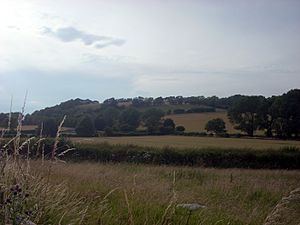Torberry Hill facts for kids
Torberry Hill (also known as Tarberry Hill or Torbery Hill) is an ancient hillfort in West Sussex, southern England. It is a special protected site called a Scheduled Ancient Monument. This means it's an important historical place that is kept safe. Torberry Hill is located inside the beautiful South Downs National Park, near the village of Harting.
On this hill, you can find the remains of different forts from the Iron Age (a very old time in history, from about 800 to 100 BC). There was an early fort, a later fort, and even a spot where an old windmill used to stand. The hill itself is a chalk spur, which means it's a ridge of chalk rock sticking out from the main South Downs.
Contents
What is Torberry Hill Made Of?
The top of Torberry Hill is made of a type of chalk called Zig Zag Chalk. Underneath that is another kind of chalk. The land around Torberry Hill is mostly farmland, with trees growing on the steep slopes.
Long ago, Torberry Hill was used for grazing animals. By the year 1399, people were already getting fined for letting too many sheep graze there! Later, in the 1500s, the hill was used for growing crops. By 1632, the land had been divided into smaller fenced areas.
Exploring the Hillfort's Secrets
Scientists have dug up parts of the fort in the past, in 1948 and again from 1956 to 1958. The fort is shaped a bit like a pear and covers an area of about 2.8 hectares (that's about 7 acres). It mostly runs from east to west.
Over time, farming has damaged parts of the fort. The old wall, called a rampart, is now just a low bank. The ditch that was once around it has mostly been filled in by plowing.
Inside the fort, archaeologists found many old storage pits that had been filled in. Pottery pieces found in these pits show they were used during the Iron Age. The pottery from Torberry Hill is very similar to pottery found at another nearby hillfort called The Trundle. Other cool things found here include a curry comb (for horses), two knives, an iron spearhead, and a horn weaving-comb. All these items are now kept in a museum in Lewes.
The Fort's Defenses
The rampart (the defensive wall) of Torberry was a "Low Dump Rampart." This means it was about 3 meters (10 feet) high. The ditch next to it might have been just as deep. The rampart was built in a special way, with a gentle slope on the inside and a very steep slope on the outside, making it hard to climb. The northern part of the rampart is downhill from the inside of the fort, and that area was too steep for people to live on.
A Timeline of Torberry Hill
Archaeologists have found hints that people might have been active on Torberry Hill even before the hillfort was built, around 600 BC. Pottery suggests that people lived on the hill starting in the Late Bronze Age.
Building the Fort
The first part of the Torberry hillfort was built between 500 and 300 BC. At first, it was a "promontory fort," meaning it only defended one part of the hill. A ditch and a bank with wooden posts (a palisade) protected the western side. There was a simple entrance to get in.
Some experts think Torberry hillfort was built to replace an older fort nearby called Harting Beacon. This makes sense because of when each fort was used.
Expanding the Fort
Around 300 BC, the defenses were made bigger to cover the whole hilltop. A new entrance was built on the east side. The old ditch and bank across the middle of the hill were leveled and used to fill in the ditch.
Later, around 200 BC, the entrance was changed again. It became a stone-walled passageway that curved inwards, leading to a large wooden gate. Stone was used to replace earlier wooden walls that held back the rampart. This shows how hillfort building techniques improved over time. Because the local chalk was soft, the stone for these walls had to be brought in from somewhere else.
Around 100 BC, this gate was destroyed. Even after that, there are signs that people continued to use the fort, even into the Roman period (from 43 AD to 409 AD).
The Fairy Bed
Much later, after the Iron Age, a type of windmill called a post mill was built on the highest part of the hill. Today, only a low, cross-shaped mound about 10 meters (33 feet) across remains. Locals call this spot the "Fairy Bed."
Fun Folklore and Legends
Torberry Hill has some interesting local stories!
One legend says that Torberry Hill was formed when the Devil burned himself tasting hot punch from the Devil's Punch Bowl in Surrey. He got so angry that he threw his spoon away, and it landed here, forming Torberry Hill!
Another local story says that there's a hidden treasure buried on Torberry Hill. In 1877, people used to say this rhyme:
Who knows what Tarberry would bear
Would plough it with a golden share
More recently, the rhyme changed a bit, suggesting you need a golden ploughshare (the blade of a plow) to find the treasure:
He who would find what Torbery would bear
Must plough it with a golden share
And finally, on Midsummer Eve, people say that fairies come to Torberry Hill to dance!




